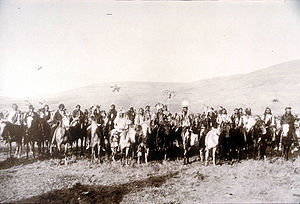Battle of Canyon Creek
| Battle of Canyon Creek | |||||||
|---|---|---|---|---|---|---|---|
| Part of the Nez Perce War | |||||||
 Chief Joseph and his band in the spring of 1877. |
|||||||
|
|||||||
| Belligerents | |||||||
|
Crow Indians |
Nez Percé | ||||||
| Commanders and leaders | |||||||
|
Samuel D. Sturgis Lewis Merrill Frederick Benteen |
Chief Joseph Looking Glass |
||||||
| Strength | |||||||
| 425 soldiers about 100 White and Indian scouts |
<200 | ||||||
| Casualties and losses | |||||||
| 4 killed 11 wounded |
7 killed 10 wounded |
||||||
The Battle of Canyon Creek was a military engagement between the Nez Perce Indians and the United States 7th Cavalry. The battle was part of the larger Indian Wars of the latter 19th century and the immediate Nez Perce War. It took place on September 13, 1877, west of present day Billings, Montana in the canyons and benches around Canyon Creek.
In June 1877, several bands of the Nez Perce, resisting relocation from their native lands on the Wallowa River in northeast Oregon to a reservation in west-central Idaho on the Clearwater River, attempted to escape to the east through Idaho, Montana and Wyoming over the Rocky Mountains into the Great Plains. By September, the Nez Perce had travelled nearly one thousand miles and fought several battles in which they defeated or held off the U.S. army forces pursuing them. The Nez Perce had the mistaken notion that after crossing the next mountain range or defeating the latest army sent to oppose them they would find a peaceful new home.
After passing through Yellowstone National Park the Nez Perce eluded the forces of Colonel Samuel D. Sturgis (see Nez Perce in Yellowstone Park) and followed the Clark’s Fork of the Yellowstone River north out of Wyoming into Montana. General O. O. Howard, who had chased the Nez Perce unsuccessfully for three months, ordered Sturgis to continue the pursuit. Sturgis had 360 men in six cavalry companies, divided into two battalions, one commanded by Major Lewis Merrill and the second by Captain Frederick Benteen. Howard reinforced Sturgis’s 360 men with 50 additional cavalrymen, two mountain howitzers, twenty-five white scouts, and a few Bannock and Crow scouts. Howard and his soldiers, whose horses were worn out, would rest and follow a couple of days behind Sturgis.
...
Wikipedia
